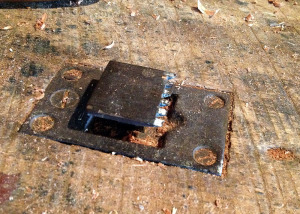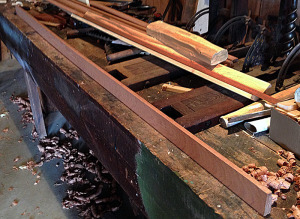The Toothed Bench Stop May Not Be So Evil After All
I got rid of my brass bench dogs a few years ago. The catalyst was probably the guys from Time Warp Toolworks who were giving away bench dogs made of Ash when I shared a booth with them at Woodworking in America in 2011. Today you will find the dog holes in my bench plugged with wooden dogs. I only dinged up a plane on a brass dog once so it isn’t like I have horror stories that drove me to wooden dogs. I think wooden dogs are like insurance: you hope you never need it but you feel good knowing it is there.
 So for a few years now I have shunned any metal bench implements other than my holdfasts…until this weekend. I worked at the Steppingstone Museum both days this weekend and brought along some mouldings that I needed to stick. Two or our continental benches just aren’t long enough for the 9 foot boards I was using so I move over to our Nicholson style bench that is about 15 feet long. This bench doesn’t have any vises or dog holes but it does have one of those metal toothed stops that you can raise and lower with a whack of the mallet. I was dubious but faced with no other alternative so I raised it up about an inch and placed my 7/8x4x9′ board on edge to be jointed. I would have much preferred my leg vise back at home for stability on this kind of board and was worried that I would be in for a shaky ride with this single stop.
So for a few years now I have shunned any metal bench implements other than my holdfasts…until this weekend. I worked at the Steppingstone Museum both days this weekend and brought along some mouldings that I needed to stick. Two or our continental benches just aren’t long enough for the 9 foot boards I was using so I move over to our Nicholson style bench that is about 15 feet long. This bench doesn’t have any vises or dog holes but it does have one of those metal toothed stops that you can raise and lower with a whack of the mallet. I was dubious but faced with no other alternative so I raised it up about an inch and placed my 7/8x4x9′ board on edge to be jointed. I would have much preferred my leg vise back at home for stability on this kind of board and was worried that I would be in for a shaky ride with this single stop.
 I was really surprised. The toothed stop grabbed on to the end grain of my board and held it firmly in place so that I was able to joint the entire 9′ edge with no problem. What’s more the board had a lot of side bend to it already so it wouldn’t register cleanly against the bench top. I marked the opposite edge and planed the next side down to the line without a problem using the same set up. Of course with the previously jointed edge down it was even more stable. Finally I like to chamfer the back side lower corner on base moulding like this to ensure a snug fit up against the case. The stop held on to the board even when I shifted my pressure from vertical to plane that chamfer.
I was really surprised. The toothed stop grabbed on to the end grain of my board and held it firmly in place so that I was able to joint the entire 9′ edge with no problem. What’s more the board had a lot of side bend to it already so it wouldn’t register cleanly against the bench top. I marked the opposite edge and planed the next side down to the line without a problem using the same set up. Of course with the previously jointed edge down it was even more stable. Finally I like to chamfer the back side lower corner on base moulding like this to ensure a snug fit up against the case. The stop held on to the board even when I shifted my pressure from vertical to plane that chamfer.
I guess in hindsight I shouldn’t be surprised because this is essentially the same thing I do on my sticking board in my own shop except I have a series of wood screws. I’m writing this mainly because I know I have been adverse to using a toothed stop like this in the past. I have read a few reviews over time too that backed up that assumption. It is possible that some of the negative reviews may have been inspired by some of the modern manufactured stops on the market, but having not used one of those I can’t say for sure. I can’t even say I’ll be looking for one of these since my current workbench has never let me down with work holding. But this experience does remind me to never discount something until I have had a chance to give it a try first. The proliferation of these metal stops from history must tell us that they were adopted by quite a few woodworkers. Maybe if I build another bench one of these will have a home.


